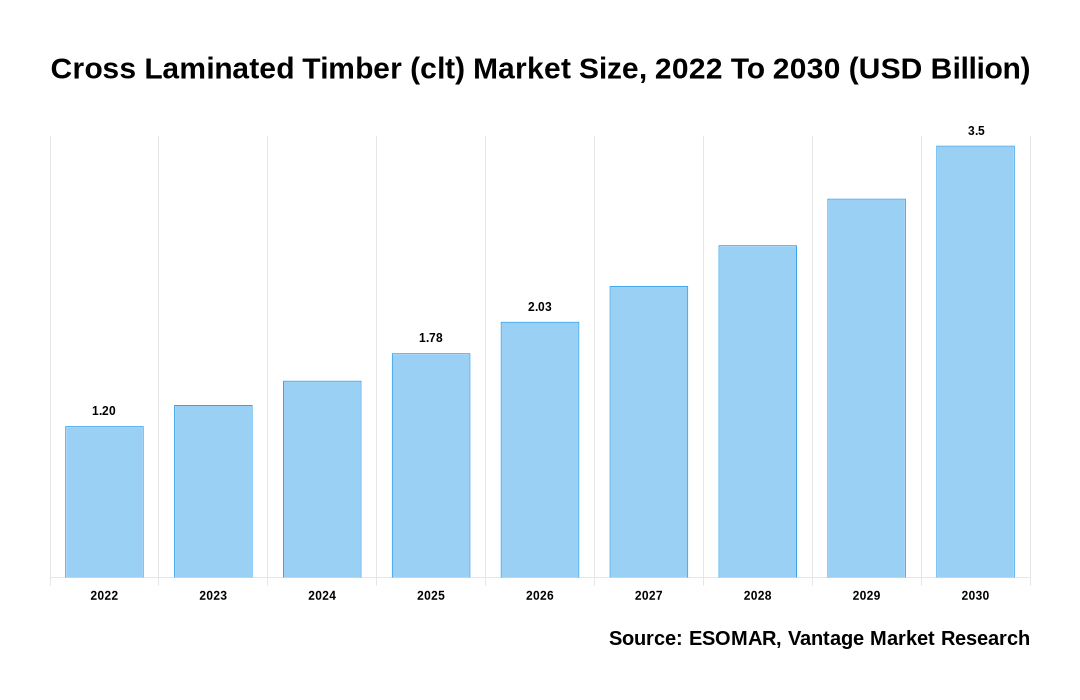Global Cross Laminated Timber (clt) Market
As stated in our extensive report, the Global Cross Laminated Timber (clt) Market accounted for USD 1.2 Billion in 2022 and is projected to reach a value of USD 3.5 Billion by 2030.
Cross Laminated Timber (clt) is an innovative, engineered wood product revolutionizing the construction industry. CLT is made by layering multiple layers of wood panels perpendicular to each other, bonding them with glue, and pressing them under high-pressure conditions. This results in a strong and stable building material that is lightweight, sustainable, and offers exceptional thermal insulation properties. There is a growing demand for sustainable construction materials that are environmentally friendly, renewable, and low in carbon emissions. CLT is a great material for sustainable construction, as it has a low carbon footprint, better energy efficiency, and recycling potential.
Furthermore, the CLT market is experiencing significant growth due to the increasing global demand for sustainable building materials. Because of its adaptability, sustainability, and low cost, CLT is perfect for various construction applications, including residential, commercial, institutional, and industrial. The CLT market is poised for continued growth, driven by regulatory support, innovative design capabilities, and the increasing adoption of sustainable construction practices. CLT will play a crucial part in satisfying the construction industry’s growing needs as the demand for sustainable materials develops.
Click To Get a Free Sample On the Research Study

Key factors influencing Cross Laminated Timber (clt) Market Growth
The growth of the global Cross Laminated Timber (clt) market can be attributable to the following:
- CLT is a sustainable building material made from renewable wood resources. It has a lower carbon footprint than traditional construction materials like concrete and steel. The increasing focus on sustainable construction practices is expected to boost the demand for CLT.
- CLT offers cost advantages over conventional building materials due to its lightweight nature, which reduces transportation and foundation costs. Additionally, its prefabrication capabilities enable faster construction, reducing labor costs and overall project timelines. This cost-effectiveness makes CLT an attractive option for builders and developers.
- CLT has excellent structural stability and strength, making it suitable for a wide range of applications, including residential, commercial, and industrial buildings. Its dimensional stability and high load-bearing capacity make it an ideal choice for tall buildings and earthquake-prone regions.
- Many governments worldwide are promoting the use of timber construction materials to foster sustainable development. Governments are providing incentives and subsidies to encourage the adoption of CLT in the construction industry. This support from governments is expected to drive the growth of the CLT market.
- The global population is rapidly urbanizing, leading to an increased demand for residential and commercial buildings. CLT offers a sustainable and efficient solution for meeting the growing housing demands in urban areas, driving the demand for CLT in the construction industry.
Europe Region to Express the Largest Market Growth
The Europe market is accounted to have the most significant market growth in 2022. Europe is at the forefront of the CLT industry, and many countries have developed manufacturing facilities to cater to the demand. According to a report by Wood for Good, CLT production capacity in Europe has increased by more than 50% in the last five years and is expected to continue to rise. The increasing demand for sustainable structures, the ease of construction, and the growing acceptance of timber as a preferred building material are driving the expansion.
North America is expected to be the fastest-growing region during the forecast period. This growth is attributed to several factors. Firstly, there is a growing trend towards sustainable and environmentally-friendly construction practices. CLT is made from renewable timber resources and has a lower carbon footprint than traditional building materials like concrete and steel. It also sequesters carbon dioxide, contributing to the reduction of greenhouse gas emissions. As sustainability becomes a key consideration in the construction industry, CLT offers an attractive alternative to conventional materials.
Conclusion
CLT’s increasing popularity in the construction industry is driven by several key factors, including its sustainability, structural durability, design flexibility, and cost-effectiveness. With these key driving factors in mind, it is no surprise that more and more builders and developers are turning to CLT as a viable option for their construction projects. As a leading building material for those looking for sustainable, long-lasting, and cost-effective building practices, we will only continue to see growth in the CLT market in the coming years.
Some of the key players in the Global Cross Laminated Timber (clt) Market includes- Stora Enso (Finland), Mayr Melnhof Holz Holding AG (Austria), Binderholz GmbH (Austria), Xlam Ltd. (Australia), Sterling Company (U.S.), Schilliger Holz AG (Switzerland), KLH Massivholz GmbH (Austria), B&K Structures (UK), Eugen Decker Holzindustrie KG (Germany), Structurlam Mass Timber Corporation (Canada), Smartlam NA (U.S.) and others.
![[Market Research Reports] – Research Google News Blog | VMR.Biz](https://www.vmr.biz/wp-content/uploads/2022/12/logo-removebg-preview.png)











